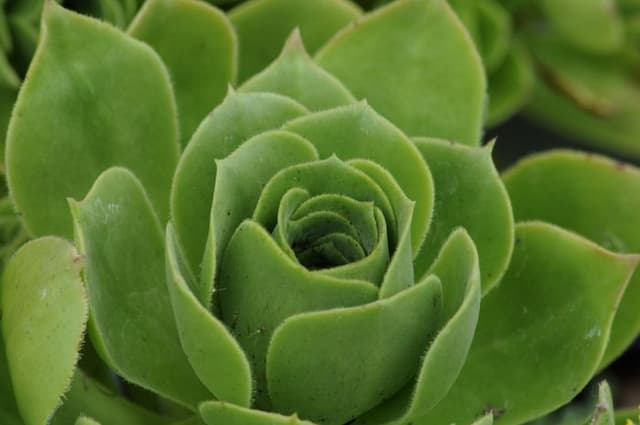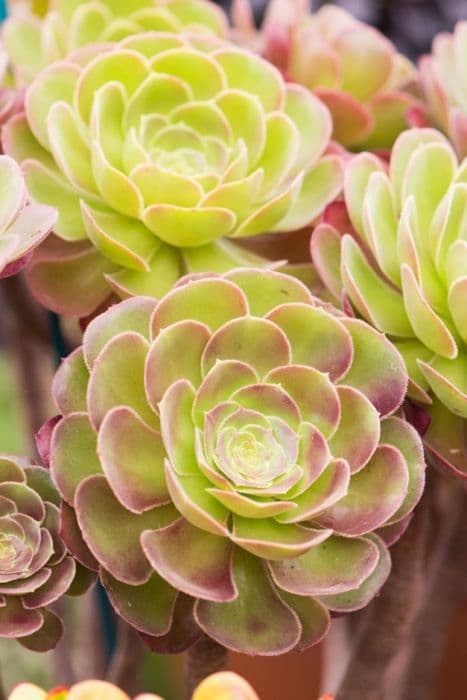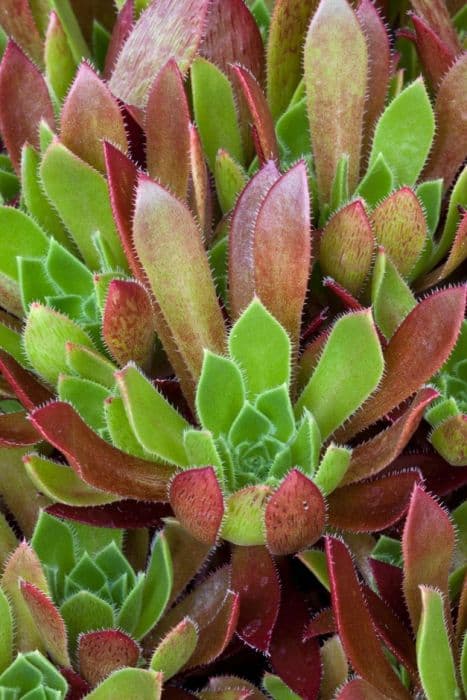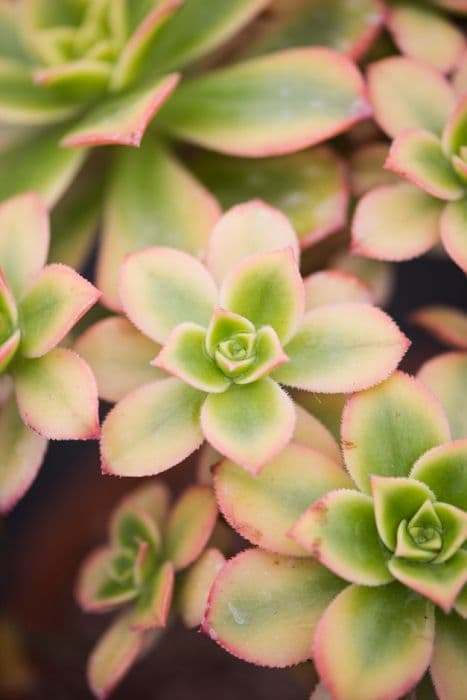Haworth's Aeonium Aeonium spathulatum

ABOUT
Aeonium spathulatum, commonly known as Oropsylla, is a succulent with a distinct appearance characterized by rosettes of fleshy leaves. These leaves are typically spoon-shaped, which is how it earns its common name, as "spathula" refers to the likeness to a spatula or spoon. The foliage color can vary, often presenting a greenish to a bluish-gray hue. The surface of the leaves usually has a powdery or waxy coating, which helps the plant conserve moisture. The leaves grow in a compact, overlapping pattern that forms the symmetrical, spiral rosettes. The rosettes themselves are often borne at the ends of the plant's branches. During certain times of the year, the Oropsylla may produce clusters of small, star-shaped flowers. These flowers can be a contrast to the leaf color, and they typically grow at the tips of the stems, adding to the ornamental quality of the plant. Overall, the visual aesthetic of Oropsylla is one of structured, geometric beauty that makes it popular in rock gardens, succulent collections, and as a potted houseplant.
About this plant
 Names
NamesSynonyms
Ogon, Yellow Aeonium
Common names
Sempervivum spathulatum, Aichryson spathulatum.
 Toxicity
ToxicityTo humans
Aeonium spathulatum, commonly known as Spoon-leaved Aeonium, is not widely recognized for being toxic to humans. However, plant toxicity can vary, and individual sensitivity may lead to different reactions. In general, it would be advisable to avoid ingesting any part of the plant, and if a person does ingest it and experiences adverse symptoms, they should seek medical advice.
To pets
Spoon-leaved Aeonium is not widely recognized for being toxic to pets. As with humans, the toxicity of plants can vary and pets might have individual sensitivities to plants that are typically considered non-toxic. If a pet ingests this plant and then displays signs of distress or poisoning, it is important to contact a veterinarian. Common symptoms of plant poisoning in pets may include vomiting, diarrhea, drooling, or lethargy.
 Characteristics
CharacteristicsLife cycle
Perennials
Foliage type
Evergreen
Color of leaves
Green
Flower color
Yellow
Height
2 feet [60 cm]
Spread
2 feet [60 cm]
Plant type
Succulent
Hardiness zones
9
Native area
Canary Islands
Benefits
 General Benefits
General Benefits- Decorative appeal: With its rosettes of spoon-shaped leaves, Aeonium spathulatum, commonly known as Oreganum, adds aesthetic value to gardens and homes.
- Drought-tolerance: Oreganum is well-adapted to dry conditions, making it an excellent choice for water-wise gardens.
- Low maintenance: This succulent requires minimal care, making it ideal for busy gardeners or those new to plant care.
- Adaptability to containers: Oreganum can thrive in pots, making it suitable for balconies, patios, and indoor settings.
- Resilience to pests and diseases: The plant is generally resistant to common garden pests and diseases, reducing the need for chemical treatments.
- Attracts pollinators: When in bloom, it produces flowers that can attract bees and other beneficial insects to the garden.
- Easy propagation: Oreganum can be easily propagated from cuttings, which allows gardeners to expand their collection or share with others.
- Long-lived: With proper care, these succulents can live for many years, providing long-term enjoyment.
 Medical Properties
Medical PropertiesThis plant is not used for medical purposes.
 Air-purifying Qualities
Air-purifying QualitiesThis plant is not specifically known for air purifying qualities.
 Other Uses
Other Uses- Aeonium spathulatum, commonly known as "Ogon", can be used as a botanical illustration subject in art for its rosette pattern and unique leaf shapes, providing inspiration for artists and educators.
- Ogon's succulent leaves can serve as a water source in emergency survival situations, where water is scarce and plants may be a necessary moisture source.
- The sap from Ogon can be used as a natural adhesive in small-scale or temporary craft projects, similarly to how some other plant saps are used.
- Ogon can be planted in green roofs where its drought-tolerant properties make it suitable for environmentally friendly building designs.
- The plant is effective in xeriscaping, a landscaping method that reduces the need for irrigation, making it ideal for water-conserving gardens.
- Ogon's contrasting colors can be used in color therapy or chromotherapy, where its vibrant hues can help create an atmosphere for relaxation or stimulation.
- The plant is sometimes used in educational projects to teach children about plant biology, particularly succulents and their adaptations to arid environments.
- This succulent can be used as natural confetti in celebrations, with its fleshy leaves creating a biodegradable and environmentally friendly alternative to paper or plastic.
- Its texture and form can be used in sensory gardens, designed to be accessible and enjoyable for individuals with sensory impairments.
- In culinary experiments, while not a common practice, the edible parts of Ogon can be used as a decorative, non-toxic garnish for various dishes.
Interesting Facts
 Feng Shui
Feng ShuiAeonium spathulatum, commonly known as spoon-leaved aeonium, is not used in Feng Shui practice.
 Zodiac Sign Compitability
Zodiac Sign CompitabilitySpoon-leaved aeonium is not used in astrology practice.
 Plant Symbolism
Plant Symbolism- Resilience: Aeonium spathulatum, commonly known as the Oyster Plant, is known for its ability to thrive in arid conditions, symbolizing the strength to persevere through tough times.
- Adaptability: This plant can adapt to various soil types and amounts of sunlight, representing the virtue of versatility and ability to adjust to different situations in life.
- Beauty and Uniqueness: The Oyster Plant's rosettes and unique appearance make it a symbol of natural beauty and the appreciation for the unusual and distinctive traits in ourselves and others.
- Endurance: As a succulent, the Oyster Plant can store water, denoting the ability to endure long periods of drought, symbolically encouraging endurance and long-lasting effort.
- Harmony and Balance: The geometric arrangement of the leaves in symmetrical rosettes symbolizes a sense of balance and harmony in life, reminding us to seek equilibrium in our own lives.
 Water
WaterThe Oonie Plant should be watered sparingly, as it is a succulent that is prone to root rot if kept too moist. Water the plant thoroughly, allowing the soil to fully saturate, and then ensure the excess water drains away completely. It is best to water the plant every two weeks, adjusting for climate and season, with more frequent watering in the hot summer months and less in the cooler winter months. When watering, aim for approximately 8-16 ounces of water per session during the growing season. During dormant periods, reduce watering frequency, only watering when the soil has completely dried out.
 Light
LightThe Oonie Plant thrives in bright, indirect sunlight and should be placed in a location where it can receive plenty of light without being exposed to harsh midday sun. An east-facing or west-facing windowsill is optimal, where it can enjoy the softer morning or late afternoon light. However, ensure that during the hottest part of the day, especially in summer, the plant is shielded from direct sunlight to prevent leaf scorching.
 Temperature
TemperatureThe Oonie Plant prefers temperatures between 65 and 75 degrees Fahrenheit for optimal growth, but it can tolerate a range from 50 to 86 degrees Fahrenheit. It is not frost-tolerant, so if temperatures dip below 50 degrees, the plant should be moved indoors or to a warmer location. Avoid placing the plant in areas with cold drafts or sudden temperature fluctuations.
 Pruning
PruningPruning the Oonie Plant is typically done to remove any dead or damaged leaves and to maintain its shape. It's best to prune in the spring or early summer when the plant is actively growing. Using clean, sharp scissors or pruning shears, snip off unwanted parts, taking care not to damage healthy tissue. Pruning every couple of months will encourage a fuller and healthier plant. Always remove spent flower stalks to direct the plant's energy into foliage and offset growth.
 Cleaning
CleaningAs needed
 Soil
SoilOarweed (Aeonium spathulatum) prefers a well-draining soil mix, such as three parts potting soil, two parts perlite, and one part coarse sand. The ideal soil pH for Oarweed should be slightly acidic to neutral, ranging from 6.0 to 7.5.
 Repotting
RepottingOarweed (Aeonium spathulatum) usually needs to be repotted every two to three years. They should be repotted during their active growth period in the spring or early summer.
 Humidity & Misting
Humidity & MistingOarweed (Aeonium spathulatum) thrives in average room humidity, around 40-50%. They do not require high humidity environments but can tolerate some variation.
 Suitable locations
Suitable locationsIndoor
Provide bright light and minimal water for indoor Oarweed.
Outdoor
Plant in sunny areas; protect from extreme cold for outdoor Oarweed.
Hardiness zone
9-11 USDA
 Life cycle
Life cycleThe Aeonium spathulatum, commonly known as Spoon Leaved Aeonium, begins its life as a seed that germinates in sandy and well-drained soils, typically after winter rains. As a succulent, it then develops fleshy, spoon-shaped leaves in rosettes that conserve water, adapting well to arid climates. The plant grows gradually, storing energy and preparing for its flowering phase. Once mature, it sends up a flowering spike with yellow flowers, usually in late winter or spring. After flowering and pollination, it sets seed, which then disperses to start the next generation. Finally, having completed its reproductive cycle, the Spoon Leaved Aeonium may die back, particularly if it is a monocarpic variety, completing its life cycle.
 Propogation
PropogationPropogation time
Spring to summer
The most popular method for propagating Aeonium spathulatum, commonly known as Oonie Plant, is through stem cuttings. To propagate, select a healthy stem and cut it using a sterile sharp knife or pair of scissors, measuring about 2 to 4 inches (5 to 10 cm) in length. Allow the cutting to dry for a few days until the cut end forms a callus, which helps prevent rotting when planted. Once the callus has formed, plant the cutting in a pot filled with a well-draining soil mix. Water sparingly, just enough to keep the soil slightly moist, but be careful not to overwater as this can cause the cutting to rot. Place the pot in a bright location with indirect sunlight and wait for roots to develop, usually within a few weeks. Once established, the new plant can be cared for like a mature Oonie Plant.









